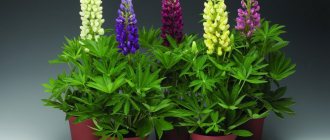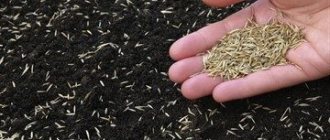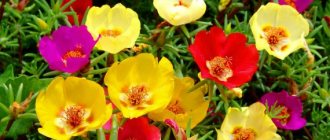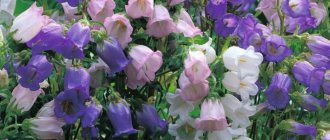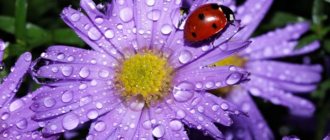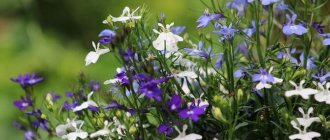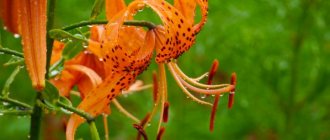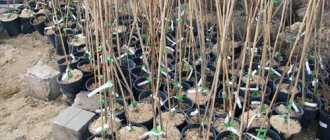Modern flower diversity allows you to choose the brightest and most interesting crops for your flowerbed. If you want to plant something not quite ordinary in your garden, but not exotic either, then pay attention to Godetia flowers, which are distinguished by the bright colors of their petals and can complement any landscape design of the site. This culture is a native of Southern California; it was studied by the Swiss botanist C. Godet, after whom it was named. Let's look at the features of this plant and the rules for caring for it.
Description of the Godetia flower
Godetia (Clarkia) is a herbaceous annual crop that belongs to the fireweed family. Since the plant genus is very close to the Clarkia genus, these specimens are often confused. The main advantages of godetia, thanks to which it has become so popular in European territories, include visual appeal and unpretentiousness.
The shoots of the crop have an erect, branched shape. The maximum height of the bushes is up to 0.6 meters. They are usually pyramidal or spreading. The leaf blades are lanceolate. The flowers are usually cup-shaped or bell-shaped, their diameter is up to 3-10 cm. Simple or terry godetia is also found. The color of the petals can be different - reddish, peach, snow-white or pinkish. There are varietal varieties that have different shades. The flower stalks on the bushes are short. At the end of flowering, a fruit with seeds is formed. Godetia flowers can be grown at home only by seed, and there are two options - sowing directly into garden conditions or for seedlings.
Pests
Godetia is damaged by various insects gnawing leaf blades and shoots, such as:
- Slugs.
- Aphid.
- Fleas.
Aphid
Insecticides will help get rid of harmful insects. The following techniques will help you avoid insect attacks:
- Compliance with planting intervals prescribed by planting standards.
- Timely removal of weeds.
- Loosening the top layer of soil after watering.
- Planting nearby plants that repel pests, in particular, you can use marigolds and calendula.
Insecticides must be used in strict accordance with the instructions on the packaging.
Planting and caring for Godetia flowers in open ground
When deciding to sow seed directly into garden soil, it is best to do this in April. In the southern territories it is allowed to plant godetia flowers for the winter.
Planting Godetia with seeds
Before sowing, the seeds must be disinfected; to do this, they are placed in a solution of potassium permanganate for half an hour. It is recommended to sow the plant in neutral or slightly acidic loamy soil.
The illumination of the area is of great importance; it must be good. Before sowing, the soil must be dug up, watered, then wood ash and some mineral fertilizers are added. It would also be useful to add humus (4-5 kg per 1 m²). It is recommended to sow seeds 0.5 cm deep. Consider that there should be at least 25 cm of free space between the bushes. To speed up the process of crop growth, cover the plantings with film material. If the seedlings are dense, you will have to thin them out a little.
Importance in landscape design
More and more gardeners are falling in love with this unpretentious, beautiful annual. Tall varieties of godetia need support, but look great against the background of openwork fences, large boulders and in alpine slide compositions.
Medium-height godetia look advantageous on the lawn, while low-growing varieties look great in flowerpots and pots in combination with other annuals. Godetia is great for growing in flower pots on the balconies of city apartments. If you transplant godetia into a flower pot for the winter, it will delight you with its marvelous blooms for a long time.
Some sources:
- Bible of garden plants / I. Berezkina, N. Grigorieva
- House in the garden No. 2 February 2018
Elena Chursinova A practical gardener with twenty years of experience. I prefer organic farming and lazy gardening.
Growing Godetia seedlings from seeds
Godetia seedlings are planted in March or early April. For planting, containers with a drainage layer and loose soil filled with nutrients are prepared. Since the seeds are too small, combine them with a sandy substrate. Then spread it over the surface of the earth, cover with a small layer of soil. The top of the container is covered with film. Every day, be sure to remove the film to ventilate and water the crops. After a month and a half, small seedlings can be observed. Immediately after this, the shelter must be removed. When the plant has formed several leaves, be sure to dig them up, remove the soil, trim the roots, and plant them in pots. 3 seedlings can be planted in 1 container.
You can learn more about growing godetia from seedlings from this video
Planting flowers in the garden
It is allowed to transplant seedlings into a flowerbed at the end of May, beginning of June. In this case, the height of the crops should be at least 6 cm. The bush must be planted together with a lump of soil so that the root system is minimally damaged. The optimal planting period is early morning or evening, so that direct sunlight does not fall on the plant. Before planting godetia, make sure that the selected area is enough to place flowers at a distance of 20-25 cm.
Features of planting before winter
Cultivation before winter is carried out only in those regions where climatic conditions are mild. But this technique is still considered more experimental. According to experienced gardeners, the best time to plant seeds is in the spring. But there are theories that seed sown in the autumn season has greater resistance to diseases and adverse weather factors.
Having decided to try this technique, the seeds are sown directly in open soil at the end of November, before the onset of frost.
You might be interested
Decorative liana Ipomoea: cultivation and use in garden design
Red perennials: the best plants to grow in the garden
Perennial shade-loving flowers and plants for the garden: a selection of the best plants
Answers to constant questions
Below are the most popular questions from novice gardeners who decided to improve their plot with Godetia.
What soil should I buy for growing seedlings?
It is recommended to use ready-made flower soil combination kits, sold in hardware stores. You can also make your own mixture for planting. To do this, you need to combine loose soil with a mixture of peat and a small amount of sand. Mix all components and use as intended.
How can you stimulate seeds for further growth?
You can stimulate the seeds with ready-made solutions (for example, Energen for garden crops or potassium permanganate) or use organic means - ash, onion peel tincture, honey solution.
Why don't the seeds germinate?
Lack of growth indicates the following reasons:
- Incorrect landing technique.
- Lack of watering or excessive watering.
- Lack of fertilizing.
- Using unsuitable fertilizers.
- Lack of good lighting.
Also, poor seedling growth may indicate unsuitable soil for Godetia.
Why are seeds soaked?
Soaking is necessary to soften the outer shell of the seeds, remove essential oils (which slow down growth) and disinfect the planting material. There is no need to soak only those seeds that were purchased in stores. Most likely, they have already been processed at the enterprise.
How to harden Godetia?
Hardening is used 1-2 weeks before planting seedlings in open ground. To do this, you need to take it out into the open air every day, gradually increasing the amount of time spent in it.
What to do if Godetia seedlings do not grow?
It is necessary to loosen the soil and look at the condition of the stem. Perhaps it began to rot from excessive watering or, on the contrary, to dry out due to lack of moisture. You should also feed the plant with mineral fertilizer, which stimulates shoot growth. The reason may lie in the lack of light. Then you will need to move the pot for growing strong seedlings to a more illuminated part of the house.
How to care for Godetia in open ground
Caring for such a plant will not be difficult, the main thing is to follow a few important recommendations.
Watering plants
It is recommended to water crops during the hot or dry season. Remember that Godetia does not like excess moisture, so waterlogging is detrimental for it. Mulching the soil is considered useful, as it helps protect the crop from drying out.
Fertilizer application
It is recommended to feed crops once a month. To do this, use mineral fertilizer with a low nitrogen content. Overfeeding of Godetia is not allowed, since in this case the active development of green mass will begin and flowering will decrease. This reduces the decorativeness of the crop.
It is also important to periodically loosen the soil to get rid of weeds. For tall varieties you will need to make supports. Metal rods or wooden sticks are suitable for this.
Diseases of Godetia
Often crop plants are damaged by root rot, which is caused by fungi or excess moisture. Having discovered such a disease, you should get rid of the flowers from the flowerbed, since their salvation is impossible.
Another disease is peronosporosis. It appears in the form of small spots on the leaves. This disease can be treated by using fungicides.
Care after flowering
After flowering is completed, the seeds begin to ripen. Once the seed pods begin to change color and become darker, carefully cut them off. Seed material can be stored in dry boxes. Seed germination is maintained for 4 years.
Further care
Correct planting and care (for Godetia to bloom magnificently) are of paramount importance.
The photos show what flowers look like if the gardener follows the following rules:
- do not forget to water (godetia is not a cactus, it does not live without water);
- do not fill with water (even in prolonged rainy weather the plant suffers);
- do not be lazy to destroy weeds in a timely manner (they are inhabited by harmful insects that love to feast on delicious godetia leaves);
— fertilize (you can use mineral fertilizers or organic matter, for example chicken droppings, the main thing is not to get carried away with nitrogen);
— from time to time, carefully loosen the soil between the plants;
- in extreme heat, it is advisable to shade godetia;
- to prolong flowering, pick off dry inflorescences and resulting fruits.
Species and varietal diversity of the Godetia flower
There are not many varieties of culture in nature. Let's look at the most popular ones.
Godetia grandiflora
The height of plant shoots is up to 0.4 meters. The leaves are lanceolate, the flowers are large - up to 10 cm in volume. The color can be different, the most common are white, scarlet, pink, red, lilac shades of the petals. The crop has been grown since 1867. The plant blooms starting in July and continues until October.
The variety is represented by a large number of varieties, both dwarf and tall.
The most popular varieties are:
- Godetia "Weisser Schwann" . The height of such a bush is 30-35 cm. The stems are green on top, and closer to the bottom they have a light brown tint. The leaf blades are broadly lanceolate in shape. The flowers are painted white, up to 5-6 cm in diameter. They are distinguished by a cup-shaped configuration and entire color.
- Variety "Orange Room" . The variety is of medium height - reaches up to 40-50 cm. It develops in the form of a branched, semi-spreading bush. Leaf blades are narrow-lanceolate. The flowers are up to 5 cm in diameter and have the shape of bells. The petals are entire, colored orange-red.
Lovely godetia (Clarkia amoena)
The height of the variety is up to 0.6 meters. The flowers are smaller - up to 5 cm. The petals are satin, can be lilac-raspberry or red-pink. Blooms later - from July to September. The flowers are cup-shaped and reach up to 5 cm in diameter. The petals are satiny, very beautiful.
Photo of the lovely Godetia
This variety has been developing in nature since 1814. Popular varieties include:
- "Crystal Snowflake" The variety is tall, reaching up to 75 centimeters. The petals are painted white.
- "Kirshkenigin" . It features beautiful reddish-pink petals.
Terry varieties of Godetia
There are a large number of varieties that captivate gardeners with their attractiveness and beauty. The most popular of them:
- "Sybil Sherwood" . The bushes are compact in shape, they grow up to 30-40 cm in height. The lanceolate leaf blades are beautiful green. Semi-double flowers reach up to 5 cm in diameter. They have a nice salmon pink hue.
- "Bride" . The flowers are double, painted white. A light pink tint can be seen on top of the petals.
- Godetia "Rembrandt " The crops reach a height of up to 30 cm and are spherical in shape. The stems are colored greenish-pink. Leaves have a narrow lanceolate configuration. The flowers are double, reaching up to 5-6 cm in diameter. The petals are wavy in shape with an interesting red spot.
Diseases
Godetia is not affected by viruses; all diseases have a fungal basis.
| Disease | Signs | Cause |
| Root rot | Plant wilting in constantly moist soil | Overmoistening of the soil during artificial irrigation |
| Rust | Stripes, spots, convex orange pads | Excessive watering, crowding |
| Downy mildew (downy mildew) | The appearance of angular drying spots on the leaves along with a white coating, shedding of buds | High humidity, watering with cold water, thickened plantings |
It is almost impossible to cure disease-affected godetia; all that remains is to remove the diseased plants.
Spraying with fungicides during budding will help prevent the disease.
Proper pruning
The tree hydrangea Anabel is beautiful, caring for it mainly involves proper pruning. This process must be approached responsibly. Improper pruning can completely destroy the beauty of the plant.
Young bushes should not be pruned until they are 4 years old. Starting from this period, branches need to be pruned in early spring. Cuts are made from the ends of the branches, retreating an average of 15 cm. Young shoots on an adult plant can be cut by a third. This is necessary for the formation of lush flowers. In the absence of pruning, the buds begin to become smaller over time.
Landing dates
Seeds are sown directly into the ground if the climate in the region is warm. Possible slight drops in temperature only harden young plants.
Autumn sowing of godetia is sometimes practiced. Then the seedlings appear after the soil warms up in early May, having gone through natural stratification. For autumn sowing, use twice as many seeds as is usually required. They are mixed with washed river sand and placed in grooves at intervals of 3 cm.
In autumn, seeds are sown after the first frost. Depending on the climate, this could be early November or late October. At this time, the soil will already freeze a little and the seeds will not have time to germinate before the onset of winter. A 4 cm thick layer of peat is used as a cover for the bed. After the seedlings emerge in the spring, they are transplanted to a permanent place.
Sowing seeds depending on the region
The timing of planting godetia when grown from seeds is determined by weather conditions. In the south and other regions with mild climates, they are sown in open ground after the soil has dried and warmed to +15°C. Typically, optimal conditions for planting seeds are created at the end of April. Soon the first shoots appear. 80 days after the sprouts appear, the time for flowering begins.
Article on the topic: Pachistachis flower: home care, photos, reproduction, signs and superstitions
In Siberia, the Moscow region and the Urals, the climate is more severe. Therefore, sowing in open ground is not practiced here. Here it is more convenient to grow godetia seedlings. Seeds are sown in boxes in mid-March. Then, by the end of May, the seedlings will have grown so much that they can be moved to the garden bed.
Sowing seeds for seedlings can be done from the end of February. But then the plants are provided with additional lighting so that the seedlings do not stretch out and are of good quality.
Sowing according to the lunar calendar: table of favorable dates
The Earth's natural satellite influences the development of all plants. Therefore, experienced gardeners recommend sowing seeds taking into account the phases of the moon. If it is growing, the movement of plant sap occurs from bottom to top. At this time, the root system is more pliable. Therefore, transplanting seedlings and sowing seeds will be successful. On the waning Moon, sap flow goes in the opposite direction. These days it is better not to sow godetia and not to do other work related to planting or replanting.
According to popular belief, it is best to plant seeds in the ground on Wednesday or Friday. These days are considered “women’s days”. On Saturday and Sunday the earth is not disturbed, as it rests.
Features of the plant
Depending on the type, godetia forms an elongated or spreading bush of small size. The length of the shoots does not exceed 60 cm. The leaves of the erect stems are arranged alternately and have a lanceolate shape. During flowering, the bush is completely covered with cup-shaped or bell-shaped flowers. The diameter of the buds ranges from 3 to 10 cm. The flowers are simple or double, collected in brushes. Their color can be any shade in the red and white color scheme.
Godetia is grown only from seeds. This plant does not reproduce vegetatively. The ripening of small seeds occurs inside a cylindrical tetrahedral capsule. They remain viable for three years.


